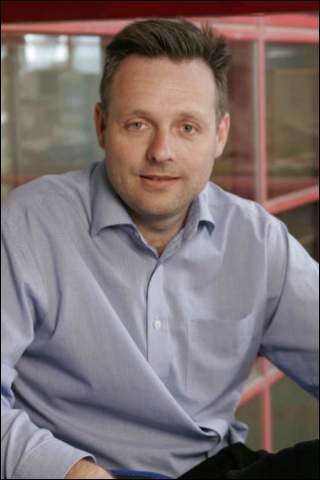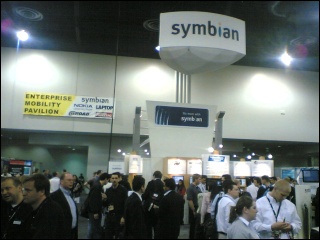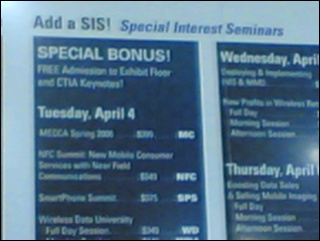 Ever wondered how many applications are out there for Symbian OS? Well you need to ask Bruce Carney. As Symbian’s head of Developer Marketing, he has the inside track on what the third party authors are up to. All About Symbian caught up with Bruce at the recent CTIA Conference in Las Vegas.
Ever wondered how many applications are out there for Symbian OS? Well you need to ask Bruce Carney. As Symbian’s head of Developer Marketing, he has the inside track on what the third party authors are up to. All About Symbian caught up with Bruce at the recent CTIA Conference in Las Vegas.
Symbian in America
How is Bruce finding ‘the City of Sin’? “Well Las Vegas is one of a kind - like walking into a large scale human zoo.” Standing in the bar of The Venetian, a renaissance styled Hotel and Casino that cost over four million dollars to build, I can certainly agree with him. “CTIA was really interesting, so many people and lots of activity, it was great to feel the buzz at the show".
Of course the American mobile phone market (and especially the smartphone market) is one that’s perceived to be a little bit out of sync with the rest of the world. “A couple of immediate things I have noticed in the US is how narrowly everyone defines a smartphone”, points out Carney. “It seems that in the US a smartphone is a device with a keyboard [witness the success of the Palm Treo] and that any smartphone is geared heavily towards enterprise applications."
"With this mindset, people aren't aware of some of the really cool applications, and devices, that are starting to appear first on Symbian OS. For example, this month I was really impressed with the Mobiola Web Cam (http://www.warelex.com/ ) application. It will turn my smartphone into a webcam (using Bluetooth) so I can use it with my laptop to see the kids at home."
And there presents an interesting challenge. Symbian has always appeared to want to sit back in terms of publicity, and leave it to its licensees (such as Nokia and Sony Ericsson). Given that, how can Symbian convey its message in the US? “We have a US office and work with a large partner community based in the US.” But Symbian is all about partnerships, Carney continues, “we also work closely with Forum Nokia in the US, for example we are participating in their upcoming road show at five sites in the US.” You can find more about the road shows at http://www.techtour2006.com/.
Back In The Real World
Away from promoting Symbian in Las Vegas, Carney is responsible for his team delivering developer marketing programs. These programs aim to get people involved in developing on Symbian OS, and to ensure that they are aware of new tools and developments. This includes Symbian Signed (http://www.symbiansigned.com/), the Symbian Developer Network (http://www.symbian.com/developer/) and the relatively new Symbian Academy (http://www.symbian.com/developer/academy/). He’s also responsible for “the Big List."
Bruce laughs at this term, “Ah, the list of all the third party software available for Symbian OS.” So what does compiling it involve? “We take data feeds from prominent web sites (such as All About Symbian), cross check it with our Symbian Signed data, and do some additional manual work referencing the application providers by region. The results are made available to Symbian Platinum partners and licensees. Symbian is in a unique position to do this on behalf of the industry. I should add that Ricky Junday, who manages the operations of Symbian Signed, does a lot of the heavy lifting, gathering and processing the data for the report.
Counting The Applications
So the golden question. How many applications are out there?
"We publish the official number of applications each quarter with our quarterly results.” Bruce is clearly teasing now. What’s the number? “4,874.” That’s the figure we have from the end of March. That’s commercial applications on Symbian OS, and it’s up from the 4,588 we counted at the end of 2005.
Why do you only count commercial applications, don’t you guys like freeware? (I jest). "We only count those applications, not because we don't like open source, freeware and bespoke apps (in fact we think these communities are great), but it is more difficult to quantify and track those applications to determine which are ‘valid’ applications."
With all those numbers to crunch, do you see any trends emerging? “Interestingly, as we see Symbian OS devices shipping in ever larger volumes, more content providers and ISVs seem prepared to make the investment to go native, i.e. use Symbian C++. That said, we also see plenty of people leveraging the multiple run-time-environments on Symbian, with cool applications in all sorts of languages including Flash, Python, OPL and .NET (using Appforge's Crossfire technology)."
So what are the challenges facing the community, from Symbian’s point of view? “With the first Symbian OS v9.x based devices now shipping (such as the Nokia 3250, Nokia N91 and Nokia N80, some very cool smartphones) the great push to migrate developers over to v9.1 has started in earnest. As many developers require a Developer Certificate (https://www.symbiansigned.com/app/page/devcertgeneral) to test on a device, we can see the developer activity increasing in this area. After 4 months, 1565 Developer Certificates have been downloaded, and month on month we see the number growing by 25 to 50 percent.” Bruce also asks a favour. “If you know developers who haven't started their v9 migration, it might worth tapping them on the shoulder to remind them that if they don't start soon, they may be missing some revenue possibilities.
So how do you count Java midlets? Is every single midlet ever written counted? “We only count Java midlets that are specifically marketed for Symbian. If the developers are paying attention to Symbian OS, then we’ll pay attention to them,” explains Carney. “Java is very popular for certain types of apps and with the Java VM integrated into the OS, Symbian OS treats Java midlets as first class citizens on the device“ So they appear as regular application icons on the system screen? “Yes, and this is one reason why Symbian is a popular target platform for Java developers.”
"There is one thing to point out though – Flash Lite applications aren’t yet included in the report. However, Flash is becoming really interesting environment for developers on Symbian OS, and we’ll expect to see much more activity with this as devices are now starting to ship with the runtime technology embedded."
There was certainly a tremendous response in the S60 Challenge ; which had a category for Symbian C++ apps as well as Flash. Closer to my phone, I downloaded the Mobizines (http://www.mobizines.com/) which is a Flash Lite application last month. It’s a nice way to check all the celebrity gossip and to fill in 15mins on a slow London bus."
Symbian Signed and Security
Everything is good in the Symbian camp, so why are there dark mutterings of application certification, ‘lock down,’ restricted APIs, malware and Trojans coming from developers, analysts and industry watchers? “Well, it’s all to do with the security changes in Symbian OS 9.1, and the Symbian Signed program.” I put it to Bruce that there was a perception of all this being ‘a great big bogeyman.’ It’s obviously a conversation that’s happened many times with many people.
"It’s only a bogeyman if you can’t get your mind past the mental hurdle of the necessity for programs such as Java Verified and Symbian Signed to provide a baseline of assurance to regular consumers, such as our mums and dads who don’t live on the bleeding edge”. And Carney continues, “They don't want their phones plagued by poor performing or ‘naughty’ applications that might send the odd premium SMS while you’re not watching. Network operators who spend a fortune to provide 99.999% network reliability aren't particularly impressed if the last link in the chain (which they still refer to as a "terminal") causes their support lines to be clogged because an application couldn't handle life on an embedded device and starts taking all the processor cycles, not switching away when a call comes in, or some other misdemeanour."
 "We have invested a lot of energy to make Symbian Signed as simple and inexpensive as possible for all different types of developers: partners, professionals and passionate (i.e. freeware) developers. The test criteria are relatively straight-forward and focus on the basics. We listen to feedback and we think the program is best-in-class and about as developer friendly as possible. That said, we will continue to improve."
"We have invested a lot of energy to make Symbian Signed as simple and inexpensive as possible for all different types of developers: partners, professionals and passionate (i.e. freeware) developers. The test criteria are relatively straight-forward and focus on the basics. We listen to feedback and we think the program is best-in-class and about as developer friendly as possible. That said, we will continue to improve."
So really for developers it's a bit like flossing our teeth: it's relatively painless; we know it's good for us; but we do need to be continually reminded of the benefits to go and do it each time.
But surely the fact of the security model in Symbian OS v9.1 means that the phone I could buy and hold in my hand is not under my complete control? Why should a network (or Nokia, or Symbian) restrict what I can do with my phone?
"Platform security is primarily protecting end users (non-developers), so it makes total sense to restrict access to the functionality that may harm their phone, cause billable events or access their personal data. For the developer, there aren't huge restrictions on access to these APIs on their own devices. By using Developer Certificates you can access most of the functionality and APIs. It's only the very inner core of APIs (e.g. TCB, DRM, etc.) that require approval from the phone manufacturers; quite frankly if you know about those APIs you probably know how to get approval to use them."
Helping the Developers
"The program celebrates its second birthday soon. We are seeing consistent month by month growth in the number of applications being signed and the number of companies engaged in the signing process. In March alone we saw over six hundred .sis files signed. As we see more applications for S60v3 and UIQ3 devices, we expect these numbers to increase."
As well as the web, there’s also now a mini book to help explain the program, isn’t there? “Yes. In March, we released a free mini book, suitable for handing out at events, shows and presentations to provide a guide on Symbian Signed. It complements our existing ‘Coding Tips’ and our planned ‘Getting Started’ guides.” And if we’re not at the trade shows? “If you are interested in finding out more about how to use these booklets in your marketing programs; please contact book_sales@symbian.com and the Symbian Press team will respond.”
The great strength of EPOC (or Symbian OS v1 through v5 if you want to keep the lineage) was the strength and number of bedroom coders, hobbyists, and one man shareware companies. Symbian Signed isn’t a free service, so are you costing them out the market?
Bruce shakes his head. “Definitely not We really want to encourage open source and freeware and have been working with our licensee community to ensure free tools are available and with the release of Carbide.c++ Express (http://www.forum.nokia.com/carbide) last February, anyone can now start developing on Symbian OS for free. Also we have a freeware signing program to satisfy these communities, and there’s https://www.symbiansigned.com/app/page/freewareFaq. Small guys, with big ideas, can also work with some of the application distributors who are ‘Publisher Certifiers’ who will sign applications on their behalf and distribute them via their channels.”
Whether this actually aids the freeware community remains to be seen – what I do know from talking to Symbian and its partners is that they are eager to cater for the smaller coders, but also that they are effectively forced to introduce these security constraints from a network security point of view. If there’s no security, then the networks just won’t buy the phones. It’s a rock and a hard place.
The Future?
Finally, where now for Symbian development? There's the large migration of existing applications to run on new Symbian OS v9.1 devices, but haven't we got all the applications we need now? Are we just waiting for the hundredth Sudoku game?
Bruce, naturally, disagrees with some of this. “I actually think we are starting to see funkier and funkier applications, rather than repeats. It never ceases to amaze me some of the ideas that are floating around out there. As well, some of the major brands have entered mobiles on Symbian OS first; for example, “Yahoo! Go Mobile” And “Sky By Mobile” (the last is only for UK Sky subscribers)... With many Symbian OS v9-based devices having specifications to-die-for (think WiFi, multi megapixel cameras, gigabyte storage capacity, high quality audio and larger screens) I think developers have only just begun to explore the apps that can be created for a mobile phone”.
And Bruce’s spreadsheet will keep on counting them? “It sure will, what Phil Spencer started, I’m duty bound to continue!”

